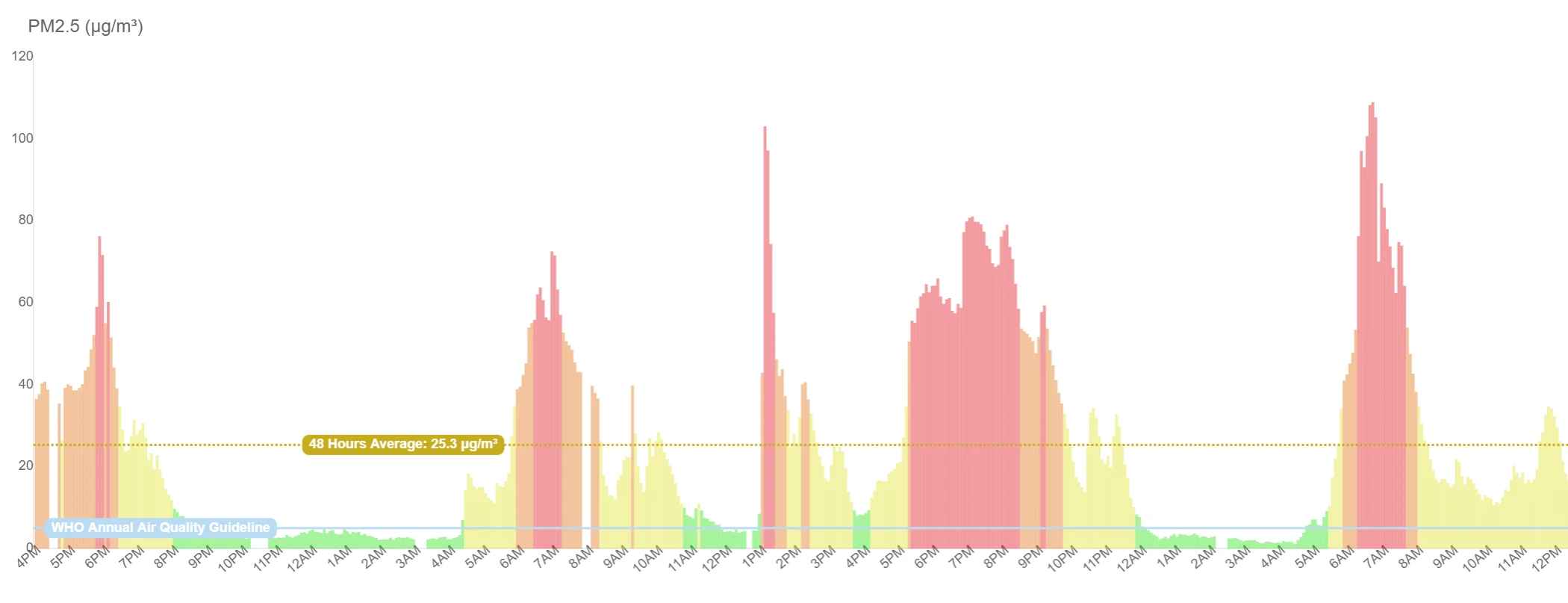AirGradient Open Source Air Quality Monitors
We design professional, accurate and long-lasting air quality monitors that are open-source and open-hardware so that you have full control on how you want to use the monitor.
Learn Moreby Ethan Brooke on July 3, 2024
Smoke, in its many forms, poses a significant health risk that cannot be underestimated. Whether it is secondhand smoke or from wildfires, cooking, or burning garbage, the harmful pollutants in smoke can severely impact our health. Understanding these dangers and knowing how to protect ourselves is essential for maintaining our well-being.
This topic is very close to my heart, as I have spent nearly a year living in the Philippines, where smoke from cooking and garbage burning is prevalent. Almost every day, I witness PM2.5 concentrations spike above 70µg/m3, with some days reaching as high as 120µg/m3. These experiences have made me acutely aware of the health dangers associated with smoke. As someone who also suffers from asthma, the impact is even more pronounced.

AirGradient was born out of a need for monitors during wildfire smoke events, a particularly dangerous type of smoke. While wildfire smoke has its unique hazards, we have already covered that topic extensively. Our journey, fueled by the goal of providing affordable monitors to identify the dangers of smoke and other air pollution, is to enable people to take necessary precautions against not only smoke but all forms of air pollution.
While the dangers of smoke are substantial, there are actions we can take to mitigate the most significant risks. With that said, understanding the health impacts is crucial, as it underscores the importance of taking measures to avoid exposure to smoke. In reality, no level of air pollution is healthy, and no smoke exposure can be considered ‘safe’.
Today, we’ll discuss the short-term and long-term health impacts of smoke, focusing on respiratory and cardiovascular effects and the specific risks for vulnerable groups. While all types of smoke are different due to different particle and gas compositions, these health impacts are generally consistent across all forms of smoke. In an upcoming article, we will also discuss the steps you can take to protect yourself.
Smoke poses immediate health risks to individuals regardless of age or pre-existing health conditions. There is a common misconception that short-term smoke exposure or exposure in healthy individuals will not have significant effects, but this is not true. The short-term impacts of exposure can be severe, affecting various bodily systems. Here are some common short-term health impacts.
Respiratory irritation is one of the most immediate and noticeable effects of smoke exposure. This can manifest in several ways.
Burning Eyes and Throat: The fine particulate matter (PM2.5 and PM10) and gases like nitrogen oxides (NOx) in smoke can irritate the mucous membranes of the eyes, nose, and throat. Symptoms include burning sensations, sore throat, and runny nose.
Coughing and Wheezing: Exposure to smoke can trigger coughing and wheezing as the body attempts to clear the inhaled particles from the respiratory tract. These symptoms are particularly pronounced in individuals with pre-existing respiratory conditions such as asthma.
Smoke can significantly impair lung function, even in healthy individuals.
Shortness of Breath: Inhalation of fine particulate matter can cause shortness of breath and chest tightness, making physical activities more difficult. This effect is due to the particles causing inflammation and narrowing of the airways.
Aggravation of Asthma: For those with asthma, smoke can trigger asthma attacks and increase the need for medication. During periods of heavy smoke, emergency room visits for asthma can increase by 17%.
Short-term exposure to smoke can also affect the cardiovascular system.
Increased Heart Rate: Smoke’s pollutants can lead to an increased heart rate and elevated blood pressure, which can strain the cardiovascular system.
Risk of Heart Attacks: Studies have shown that short-term exposure to high levels of particulate matter can increase the risk of heart attacks, particularly in older adults and those with pre-existing heart conditions.
Smoke exposure can lead to a range of general symptoms that cause discomfort and affect daily life.
Headaches and Dizziness: The combination of pollutants and reduced oxygen levels can cause headaches, dizziness, and light-headedness. Individuals living in areas with significant smoke pollution often report these symptoms.
Fatigue and Weakness: Exposure to smoke can result in a feeling of fatigue and general weakness, making it difficult to perform everyday tasks. This is partly due to the body’s increased effort to cope with the inhaled toxins and reduced oxygen supply.
The short-term health impacts of smoke are significant and can affect anyone, regardless of their overall health status. Respiratory irritation, reduced lung function, cardiovascular effects, and general symptoms like headaches and fatigue are common. Monitoring air quality and taking preventive measures, such as staying indoors and using air purifiers, are essential to mitigate these immediate health risks during smoke events.
The long-term health impacts of smoke inhalation are serious and can have lasting effects on various bodily systems. Prolonged exposure to smoke can lead to the development and exacerbation of chronic diseases, significantly affecting quality of life and overall health. Here are some of the major long-term health impacts.
Prolonged exposure to smoke can lead to the development and exacerbation of chronic respiratory diseases.
Chronic Obstructive Pulmonary Disease (COPD): Continuous inhalation of fine particulate matter (PM2.5 & PM10) can cause chronic inflammation and damage to the respiratory system, increasing the risk of COPD. Studies have shown that individuals exposed to high levels of PM2.5 over time have a higher incidence of COPD.
Asthma: Long-term exposure to smoke can exacerbate asthma, leading to more frequent and severe asthma attacks. Chronic exposure to pollutants like nitrogen oxides (NOx) and volatile organic compounds (VOCs) can also contribute to the development of asthma in previously healthy individuals.
We at AirGradient work with the Central California Asthma Collaborative to set up more monitoring stations across the Central Valley to warn citizens with Asthma about elevated pollution levels, showing the power of low-cost air quality monitoring networks.
Long-term exposure to pollutants in smoke is associated with an increased risk of cardiovascular diseases.
Heart Disease: Extended exposure to fine particulate matter and other pollutants can lead to chronic inflammation, oxidative stress, and vascular damage, increasing the risk of heart disease. Research has linked long-term PM2.5 exposure to a higher incidence of heart attacks and other cardiovascular conditions.
Strokes: The same pollutants that contribute to heart disease can also increase the risk of strokes. Long-term exposure to smoke can lead to the formation of blood clots and other vascular issues that elevate stroke risk.
Certain compounds in smoke, such as polycyclic aromatic hydrocarbons (PAHs) and VOCs, are known carcinogens.
Lung Cancer: Prolonged exposure to PAHs and other carcinogenic compounds in smoke can increase the risk of lung cancer. The International Agency for Research on Cancer (IARC) has classified several PAHs as carcinogenic to humans.
Other Cancers: Exposure to VOCs like benzene and formaldehyde, which are prevalent in smoke, is associated with an increased risk of cancers such as leukaemia and lymphomas.
Long-term exposure to the pollutants in smoke can weaken the immune system, making individuals more susceptible to infections and other health issues.
Increased Susceptibility to Infections: Chronic exposure to fine particulate matter and other pollutants can impair immune function, reducing the body’s ability to fight infections. This can lead to a higher incidence of respiratory infections and other illnesses.
Chronic Inflammation: The constant presence of inflammatory pollutants in smoke can lead to chronic inflammation in the body, which is linked to various health problems, including autoimmune diseases and metabolic disorders.
Certain groups are more vulnerable to the harmful effects of smoke inhalation and, therefore, need to be particularly aware of the associated health risks. Smoke poses severe health threats due to its toxic composition, which includes fine particulate matter (PM2.5), carbon monoxide (CO), volatile organic compounds (VOCs), and other hazardous pollutants. These pollutants can exacerbate pre-existing conditions, impair immune responses, and lead to severe health complications.
Children are among the most vulnerable to the health impacts of smoke:
Developing Respiratory Systems: Children’s lungs and respiratory systems are still developing, making them more susceptible to damage from inhaled pollutants. Exposure to fine particulate matter can lead to long-term respiratory issues and reduced lung function.
Higher Respiratory Rates: Children breathe more air per body weight than adults, increasing their exposure to airborne pollutants. This heightened exposure can lead to more severe respiratory symptoms and health issues.
Increased Risk of Asthma: Long-term exposure to smoke can increase the risk of developing asthma and other allergic conditions in children. Those with pre-existing asthma may experience more frequent and severe attacks.
Older adults are at higher risk of health complications from smoke:
Chronic Health Conditions: Many elderly individuals suffer from chronic respiratory and cardiovascular conditions, which can be exacerbated by exposure to smoke. Fine particulate matter can worsen symptoms of chronic obstructive pulmonary disease (COPD), heart disease, and other chronic illnesses.
Weakened Immune Systems: Aging is associated with a natural decline in immune function, making older adults more susceptible to infections and other health issues caused by pollutants in smoke.
Increased Mortality Risk: Studies have shown that periods of high pollution, including smoke events, correlate with increased mortality rates among the elderly due to exacerbation of respiratory and cardiovascular conditions.
People with pre-existing health conditions need to be particularly cautious during smoke events:
Respiratory Diseases: Individuals with asthma, COPD, and other respiratory diseases are at higher risk of experiencing severe symptoms and complications from smoke exposure. The fine particulate matter and toxic gases can trigger asthma attacks, increase the frequency of exacerbations, and lead to hospitalisations.
Cardiovascular Diseases: Those with heart conditions, including coronary artery disease and heart failure, are more vulnerable to the cardiovascular effects of smoke. Pollutants can increase the risk of heart attacks, strokes, and other cardiovascular events.
Diabetes: People with diabetes may experience worsened symptoms and an increased risk of cardiovascular complications due to the inflammation and oxidative stress caused by smoke pollutants.
Individuals with weakened immune systems are particularly at risk.
Increased Susceptibility to Infections: Immunocompromised individuals, such as those undergoing chemotherapy, living with HIV/AIDS, or taking immunosuppressive medications, are more susceptible to respiratory infections and other complications from smoke.
Exacerbation of Existing Conditions: The presence of toxic pollutants in smoke can exacerbate existing health conditions, leading to increased morbidity and potential hospitalisations.

Smoke exposure can have severe impacts, especially over the long term, affecting respiratory, cardiovascular, and immune systems and leading to chronic health conditions. However, these impacts can be avoided by proactively protecting ourselves. The first and most crucial step is to monitor air quality and know when to take protective measures.
It’s important to understand that while the dangers of smoke inhalation are significant, we can take effective steps to safeguard our health. This isn’t a doom-and-gloom scenario but rather a call to be aware of the risks and take action to mitigate them - especially if you live in an area prone to smoke, whether from wildfires, trash burning, cooking, or otherwise.
This is where low-cost air quality monitors become invaluable, providing real-time data to help you make informed decisions about your health, especially as smoke exposure can happen both indoors and outdoors.
Stay tuned for our upcoming article, where we will discuss practical ways to protect yourself during severe smoke events.
Curious about upcoming webinars, company updates, and the latest air quality trends? Sign up for our weekly newsletter and get the inside scoop delivered straight to your inbox.
Join our Newsletter
We design professional, accurate and long-lasting air quality monitors that are open-source and open-hardware so that you have full control on how you want to use the monitor.
Learn More